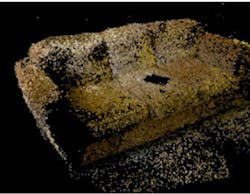Room reconstruction in 3-D
Researchers at Cambridge University (Cambridge, UK) have developed software that can automatically reconstruct a 3-D model of the interior of rooms simply by processing video clips taken with a smart-phone or digital camera.
Several similar software packages are commercially available. However, these require that an individual provides information about the geometry of the room in the form of measured dimensions or 2-D drawings. The software then generates the 3-D layout of the room, and the customer can choose and place pieces of furniture and evaluate how they fit.
While useful, the approach requires manually measuring the dimensions, which can ultimately be exhausting and potentially inaccurate.
To tackle this issue, Ioannis Brilakis, the Laing O'Rourke lecturer of construction engineering at Cambridge University and his group, worked on developing software to achieve the same goals by processing video clips from a smart phone or camera.
Before videoing a scene, a user must place a simple letter-size sheet of paper in the room, and then video the room from different views. The captured video is then sent to a server for processing where a point cloud is generated from it.
Although, the point cloud is to an unknown scale -- the absolute scale can be formulated from the known dimensions of the sheet of paper in the scene. After processing, the generated point cloud is sent back to the user who can browse it in 3-D.
More information can be found here.
Related articles on 3-D technology from Vision Systems Design that you might also find of interest.
1. MIT system captures 3-D images of zebrafish larvae
Researchers at MIT (Cambridge, MA, USA) have built an automated system that can rapidly produce 3-D, micron-resolution images of thousands of zebrafish larvae and precisely analyze their physical traits.
2. Archaeological collections scanned in 3-D
The Sustainable Archaeology Animation Unit (SAAU) of Sustainable Archaeology has taken steps to make Ontario's archaeological records accessible to researchers, students, and the public by scanning them with a 3-D scanner from 3D3 Solutions (Burnaby, BC, Canada).
3. Sonar maps sunken warship in 3-D
A new 3-D sonar map released this month shows never-before seen details of the USS Hatteras, the only Union warship sunk in combat in the Gulf of Mexico during the Civil War.
-- Dave Wilson, Senior Editor, Vision Systems Design
